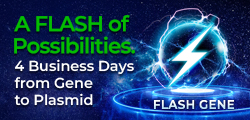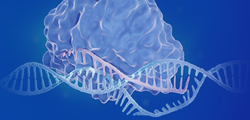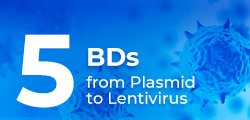-
REAGENT SERVICES
Hot!
-
Most Popular Services
-
Molecular Biology
-
Recombinant Antibody/Protein
-
Reagent Antibody
-
CRISPR Gene Editing
-
DNA Mutant Library
-
IVT RNA and LNP Formulations
-
Oligo Synthesis
-
Peptides
-
Cell Engineering
-
- Gene Synthesis FLASH Gene
- GenBrick™ Up to 200kb
- Gene Fragments Up to 3kb now
- Plasmid DNA Preparation Upgraded
- Cloning and Subcloning
- ORF cDNA Clones
- mRNA Plasmid Solutions New!
- Cell free mRNA Template New!
- AAV Plasmid Solutions New!
- Mutagenesis
- GenCircle™ Double-Stranded DNA New!
- GenSmart™ Online Tools
-
-
PRODUCTS
-
Most Popular Reagents
-
 Instruments
Instruments
-
Antibodies
-
ELISA Kits
-
Protein Electrophoresis and Blotting
-
Protein and Antibody Purification
-
Recombinant Proteins
-
Molecular Biology
-
Stable Cell Lines
-
Cell Isolation and Activation
-
 IVD Raw Materials
IVD Raw Materials
-
 Therapy Applications
Therapy Applications
-
Resources
-
- All Instruments
- Automated Protein and Antibody Purification SystemNew!
- Automated Plasmid MaxiprepHot!
- Automated Plasmid/Protein/Antibody Mini-scale Purification
- eBlot™ Protein Transfer System
- eStain™ Protein Staining System
- eZwest™ Lite Automated Western Blotting Device
- CytoSinct™ 1000 Cell Isolation Instrument
-
- Pharmacokinetics and Immunogenicity ELISA Kits
- Viral Titration QC ELISA Kits
- -- Lentivirus Titer p24 ELISA KitHot!
- -- MuLV Titer p30 ELISA KitNew!
- -- AAV2 and AAVX Titer Capsid ELISA Kits
- Residual Detection ELISA Kits
- -- T7 RNA Polymerase ELISA KitNew!
- -- BSA ELISA Kit, 2G
- -- Cas9 ELISA KitHot!
- -- Protein A ELISA KitHot!
- -- His tagged protein detection & purification
- dsRNA ELISA Kit
- Endonuclease ELISA Kit
- COVID-19 Detection cPass™ Technology Kits
-
- Automated Maxi-Plasmid PurificationHot!
- Automated Mini-Plasmid PurificationNew!
- PCR Reagents
- S.marcescens Nuclease Benz-Neburase™
- DNA Assembly GenBuilder™
- Cas9 / Cas12a / Cas13a Nucleases
- Base and Prime Editing Nucleases
- GMP Cas9 Nucleases
- CRISPR sgRNA Synthesis
- HDR Knock-in Template
- CRISPR Gene Editing Kits and Antibodies
-
![AmMag™ Quatro Automated Plasmid Purification]() AmMag™ Quatro automated plasmid purification
AmMag™ Quatro automated plasmid purification
-
![Anti-Camelid VHH]() MonoRab™ Anti-VHH Antibodies
MonoRab™ Anti-VHH Antibodies
-
![ELISA Kits]() ELISA Kits
ELISA Kits
-
![Precast Gels]() SurePAGE™ Precast Gels
SurePAGE™ Precast Gels
-
![Quatro ProAb Automated Protein and Antibody Purification System]() AmMag™ Quatro ProAb Automated Protein and Antibody Purification System
AmMag™ Quatro ProAb Automated Protein and Antibody Purification System
-
![Target Proteins]() Target Proteins
Target Proteins
-
![AmMag™ Quatro Automated Plasmid Purification]() AmMag™ Quatro automated plasmid purification
AmMag™ Quatro automated plasmid purification
-
![Stable Cell Lines]() Stable Cell Lines
Stable Cell Lines
-
![Cell Isolation and Activation]() Cell Isolation and Activation
Cell Isolation and Activation
-
 IVD Raw Materials
IVD Raw Materials
-
![Quick
Order]() Quick Order
Quick Order
-
![Quick
Order]() Quick Order
Quick Order
- APPLICATIONS
- RESOURCES
- ABOUT US
- SIGN IN My Account SIGN OUT
- REGISTER
Resources » Reference Databases » Citations Database
Services & ProductsNews & Blogs- Quick and economical method of determining the specificity of antibody drug lead and target-binding moiety for the target
- Clinicians Use Psychedelic Mushrooms To Treat Depression
- Measles Attack: Ultra-Fast Virus Detection by Peptide Libraries
- Microprotein plays key role in modulating UPR in response to ER stress
- Why are CHO Cells Critical in Bioprocessing?
- The Future of Neoantigen Vaccines: How Nanoparticles, Liposomes, and Viral Vectors Are Revolutionizing Treatment as Novel delivery System
- Three Inventive Biomedical Applications for Synthetic Peptides
- New Targets in Treating Amyotrophic Lateral Sclerosis (ALS), a Neurodegenerative Disease, Identified Using CRISPR
For each citation that was shared on social media (LinkedIn, Facebook, or Twitter) with the “@GenScript” tag, the author will be rewarded with a $10 Amazon gift card or 2,000 GS points.Two novel tau antibodies targeting the 396/404 region are primarily taken up by neurons and reduce tau pathology.
J Biol Chem.. 2013-10;Gu J, Congdon EE, Sigurdsson EM. New York University School of Medicine, United States.Products/Services Used Details Operation Abstract
Aggregated tau proteins are hallmarks of Alzheimer's disease and other tauopathies. Recent studies from our group and others have demonstrated that both active and passive immunizations reduce tau pathology and prevent cognitive decline in transgenic mice. To determine the efficacy and safety of targeting a phospho epitope versus a non-phospho epitope, we developed two novel monoclonal antibodies (mAbs) with these distinct properties against the 396/404 region of the tau protein. The two mAbs significantly reduced phosphorylated soluble tau in long-term brain slice cultures without apparent toxicity, suggesting the therapeutic importance of targeting the 396/404 region, regardless of its phosphorylation st... More
Aggregated tau proteins are hallmarks of Alzheimer's disease and other tauopathies. Recent studies from our group and others have demonstrated that both active and passive immunizations reduce tau pathology and prevent cognitive decline in transgenic mice. To determine the efficacy and safety of targeting a phospho epitope versus a non-phospho epitope, we developed two novel monoclonal antibodies (mAbs) with these distinct properties against the 396/404 region of the tau protein. The two mAbs significantly reduced phosphorylated soluble tau in long-term brain slice cultures without apparent toxicity, suggesting the therapeutic importance of targeting the 396/404 region, regardless of its phosphorylation status. In mechanistic studies, we found that neurons were the primary cell type that internalized the mAbs, whereas a small amount of mAbs was taken up by microglia cells. Within neurons, the two mAbs were highly colocalized with distinct pathological tau markers, indicating their affinity towards different stages or forms of pathological tau. Moreover, the mAbs were largely co-localized with endosomal/lysosomal markers, and partially co-localized with autophagy pathway markers. Additionally, the Fab fragments of the mAbs were able to enter neurons, but unlike the whole antibodies, the Fab fragments were not specifically localized in pathological neurons. In summary, our tau mAbs were safe and efficient to clear pathological tau in a brain slice model. Fc-receptor mediated endocytosis and the endosome/autophagosome/lysosome system are likely to have a critical role in antibody-mediated clearance of tau pathology.Keywords
Alzheimer's disease; Antibodies; Endosomes; Immunotherapy; Lysosomes; Tau; autophagosomes; phosphorylation
-




































